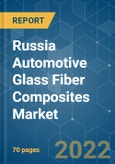The Russia automotive glass fiber composites market is expected to register a CAGR of over 3.5%, during the forecast period, 2020 - 2025.
The major growth drivers associated with this market are the rise in automotive production and the increasing demand for durable and lightweight materials because of stringent government regulations to reduce greenhouse gas emissions
The future of the global automotive glass fiber composites market looks bright with opportunities in different automobile applications, such as interiors, exteriors, structural assembly, powertrain and engine components, electrical and electronics, and others. The market for glass fiber composites in automobile structures is expected to be the fastest-growing segment, due to the wide variety of applications.
Strategic alliances between car manufacturers, glass fiber, and resin suppliers are the trends that have a direct impact on the dynamics of the automotive composites industry. Within the intermediates type, short fiber thermoplastic (SFT), long fiber thermoplastic (LFT), and continuous fiber thermoplastic (CFT) are the major ones that are used in automotive applications. SFT is expected to be the largest market by value, mainly driven by applications in powertrain and engine components applications, which feature small complex-shaped components.actuators. Hydraulic oil can leak, which can lead to serious contaminant and is difficult to clean. However, with proper maintenance, the risk of hydraulic leakage is significantly reduced.
As a result, OEMs are still making hydraulic actuators one of the main areas of focus to improve heavy-duty vehicle’s safety and comfort. For instance, truck lifts heavy load to deposit tons of sand at construction sites. A hydraulic motor also helps steer the wheels changing direction with the flow of oil controlled with the steering wheel.
Key Market Trends
Increasing Adoption of Glass Fiber Composites in Automobiles
Although automobiles have been around for more than a century, the materials they are made of have mostly remained the same. Only since the past few decades that advanced materials, ranging from magnesium alloys to glass fiber composites, have made their way into new-generation cars. Advanced materials, such as glass fiber composites, are essential for boosting the fuel economy of modern cars, maintaining performance and safety. Since it takes lesser energy to accelerate a lighter object than a heavier one, lightweight materials offer great potential for increasing vehicle efficiency. A 10% reduction in the vehicle's weight can transpire to a 6-8% increase in fuel economy.
Manufacturers are working to reduce overall vehicle weight, which lowers the energy required to operate the vehicle, increasing fuel economy. The Body-In-White system is the critical focal point for automakers looking for fuel savings because of its weight reduction potential, importance to crash safety, and impact on compounded weight reduction for other sub-systems, such as the powertrain.
Glass fiber composites are materials that have become popular in the past few years. One of the reasons for fiberglass composite's relative success is that it has several advantages when compared to steel. It is corrosion-resistant, has significant chemical resistance, and is lightweight (three times less dense than steel). Fiberglass composite is mainly used in bumpers, hoods, and casings. Another area where this material is used is V-belts and timing belts, where glass strings are impregnated with rubber acting as reinforcement. Abrasion resistance is one other advantage of the fiberglass composite, which is why it is used for producing clutches and brake pads. Clutch disks are reinforced with woven fiberglass composites to maintain their integrity.
Russia is driving the Glass Fiber Composites Market in Asia
Often materials are not recycled and sent to landfills. Environmental Protection Agency (EPA) proposed life cycle assessment (LCA) studies to detect higher emissions over the vehicle's entire life cycle. LCA looks at resources, energy, emissions, extraction phase, end-of-life phase, and disposal, and recycling. As a result, there is growing importance being given to lightweight glass fiber composites and its recyclability process due to regulations to limit GHG emissions from vehicles.
The Russia automotive is a growing market due to the presence of many car manufacturers, such as LADA, Kia, Hundai, Renault and Volkswagen, who are adopting glass fiber composites in their cars. Government regulations, and greenhouse gas emission targets is also paving the way for OEMs to incorporate lightweight materials to decrease the overall vehicle weight.
The Russia is one of the leading automobile manufacturing countries globally. The country has recovered to a reasonable extent from the economic recession that adversely affected the country's economic condition. More than 1.7 million automobiles were sold in Russia in 2018. With an increase in the production of passenger vehicles and SUVs, the demand for fiberglass in the reinforcements of automotive components is expected to increase during the forecast period significantly.
Competitive Landscape
The Russia automotive glass fiber composites market is fragmented with existing market players such as Solvay Group, 3B (Braj Binani Group), Owens Corning, Veplas Group, and SAERTEX GmbH & Co.KG, who holds the most significant shares. To have the edge over its competitors' companies are making joint-ventures, partnerships, launching new products with advanced technology.
Additional Benefits:
- The market estimate (ME) sheet in Excel format
- 3 months of analyst support
This product will be delivered within 2 business days.
Table of Contents
Methodology

LOADING...








